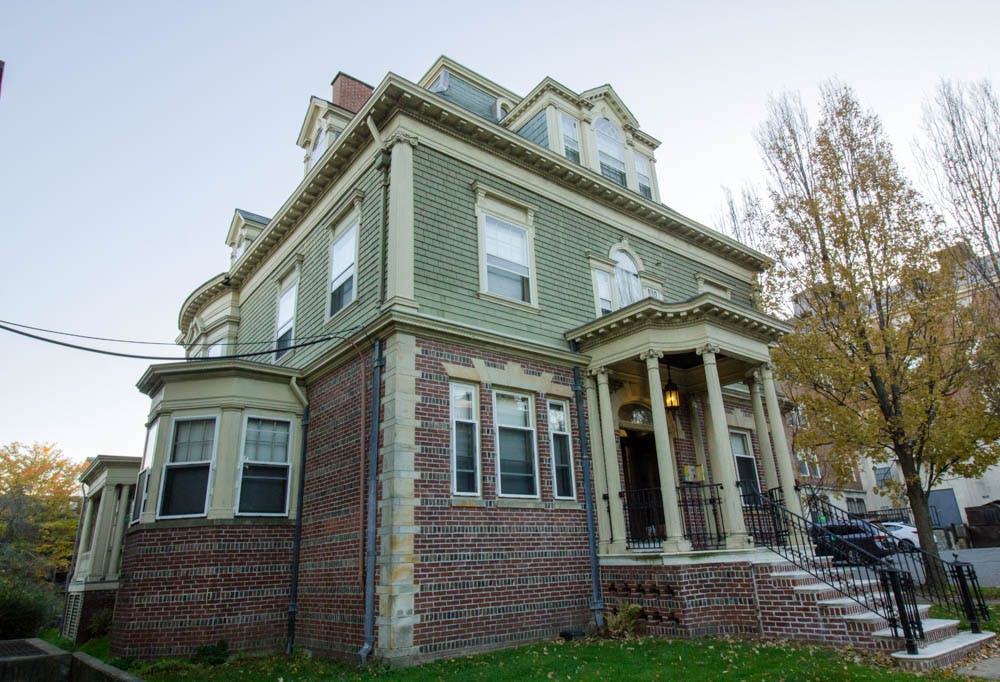The Department of Facilities Management will work with a painting contractor certified by the Environmental Protection Agency to repaint areas of Donovan House over winter break following students’ detection of lead in chipping wall paint. The residents of Donovan House — an on-campus, substance-free dorm at 219 Bowen Street — tested areas of the house’s interior walls for lead in early October, according to Jasmine White ’19. Upon inspection, Environmental Health and Safety concluded that the chipping paint in the building is unlikely to cause lead exposure, Director of EHS Stephen Morin wrote in an email to The Herald.
Many University buildings — including Donovan House — were constructed before 1978, the year when production of lead-based house paint was banned, Morin wrote. As a result, many dorms and academic buildings contain lead-based paint. “The presence of lead paint itself does not pose an exposure hazard,” he wrote. “The primary routes of exposure are inhalation and ingestion when there is significant paint damage.” Inspectors found only minor paint damage in Donovan House, he added.
Facilities Management routinely paints over the walls inside University buildings and retouches areas where paint has deteriorated, said Director of Residential Life Melissa Flowers. Because of this, many layers of paint without lead cover the old lead-based paint.
“Per guidelines from the U.S. Environmental Protection Agency, the safest remedy for minor damage where lead paint may be present is to repair and repaint,” Morin wrote.
Chipping paint can expose old layers of lead paint that have been covered, Flowers said. Lead can pose health risks when it is consumed, but the chance of consuming lead in old wall paint is small, she explained. In addition, lead exposure is primarily dangerous for children under the age of six, she said.
Though Donovan House residents who spoke with The Herald expressed some concern over the health risks posed by lead exposure, White said she does not feel unsafe living in Donovan House while waiting for Facilities Management to repaint the walls. “To my knowledge, our exposure isn’t super high,” she said. “But if there is paint that could cause lead exposure, it’s better to err on the side of caution and not have it present at all.”
Kiana Phillips ’19, another Donovan House resident, said the lead paint makes her feel more uncertain than unsafe. “There’s definitely this air of mystery about where there is and isn’t lead exposure in the house,” she said. “But I don’t feel overburdened by the hazardousness.”
Facilities Management conducts annual inspections of most rooms after students move out of their dorms in May. If inspectors see damaged paint during their annual inspections, Facilities Management will repaint portions of the wall as needed, Flowers said. Since dorms are evaluated in May, paint damage can only be caused by wear and tear that occurs in the time between room inspections, she added.
Phillips, who lived in Donovan House last year as well, recalls the wall paint being similarly chipped before she moved out for the summer. “Why did they miss that?” she said. “What are they not testing?”
Not all chipped paint is serious enough to require repainting, Flowers said. The University has added many layers of non-lead-based paint since 1978, so “really superficial scratches are okay,” she said.
If students see chipped paint in their dorm rooms, they should not be alarmed, but they should report it, Flowers added. “That should be a quick call to Facilities Management,” she said. “They’ll come and evaluate it and see whether or not it needs to be touched up.”
White said she was comforted to learn that Facilities Management handles chipping paint through their annual room inspections. But Phillips said that the lead detected in Donovan House suggests a flaw in the University’s process of covering up lead paint. “The system should not rely on students reporting (chipped paint),” Phillips said. “Right now, whatever system they have doesn’t really seem to be working.”
After detecting lead in their chipping wall paint, Donovan House residents — including Phillips and White — asked the University to publicize the presence of lead paint in the walls of many buildings on campus.
ResLife and Facilities Management are working with residents of Donovan House to develop a fact sheet that notifies students of lead paint’s existence in dorm walls under more recent layers of paint. It also explains why students should report chipped paint, Flowers said. This notification will be completed in time for the spring semester and will be included in housing contracts moving forward. “We’d rather inform students than have them living in fear in their own spaces,” she added.
White and Phillips both agreed that ResLife and Facilities Management must make students aware that there is lead paint in many dorms without causing panic. “I don’t want students to feel like, ‘I’m going to die,’” White said. “It’s not like that. But it still should be addressed.”





